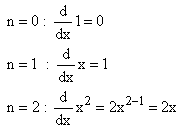|
|
||
|
|
||
|
The following rules allow us to find algebraic formulae for the derivative of most differentiable functions we know how to write down.
![]() ,
for any constant c Proof of 1
,
for any constant c Proof of 1
![]()
![]()
In particular
![]()
y = f(u), u = g(x), f and g differentiable.
Then
![]()
Suppose the function f(x) is defined by an equation: g(f(x),x)=0, rather than by an explicit formula.
Then g is a function of two variables, x and f.
Thus g may change if f changes and x does not, or if x changes and f does not.
Let the change in g arising from a change, df, in f and none in x be a(f,x)df, and let the change in g from a change, dx, in x and none in f be b(f,x).
The total change in g must vanish since g is a constant, (0), which gives us
a(f,x)df + b (f,x)dx = 0
or
![]()
Comment on implicit differentiation
Examples of implicit differentiation
![]()
In particular,
![]()
![]() for
any power n, integer, rational or irrational.
for
any power n, integer, rational or irrational.
hence,
![]()
implies
